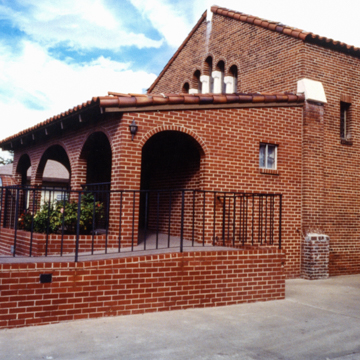Though somewhat altered from its original appearance, this church in the North Italian Romanesque Revival style, loosely resembling Sant' Ambrogio in Milan, presents a counterpoint to the Sparks Museum. The cruciform brick building has a single nave with transept, all covered by a long red-tiled gable roof. Pairs of arched windows pierce the side walls flanked by brick buttresses. A brick-clad, shed-roofed vestibule with arched openings applied to the facade in 1970 has obscured the clean lines of the main elevation. The unadorned interior has a slightly vaulted ceiling from which hang six original black wrought iron chandeliers in a simple Mission Revival style. The bell that hangs in the tower at the rear of the building came from a firehouse in Virginia City and was purchased by Father William Devlin in 1938. The oldest extant Catholic church in Sparks, Immaculate Conception replaced an earlier structure, built in 1905, that burned down on Easter Sunday in 1930. Its construction coincided with the granting of diocesan status to Nevada by Pope Pius XI in 1931. The dedication of the church on 22 February 1932 marked a time of growth for the Catholic Church in Nevada.
You are here
Immaculate Conception Roman Catholic Church
If SAH Archipedia has been useful to you, please consider supporting it.
SAH Archipedia tells the story of the United States through its buildings, landscapes, and cities. This freely available resource empowers the public with authoritative knowledge that deepens their understanding and appreciation of the built environment. But the Society of Architectural Historians, which created SAH Archipedia with University of Virginia Press, needs your support to maintain the high-caliber research, writing, photography, cartography, editing, design, and programming that make SAH Archipedia a trusted online resource available to all who value the history of place, heritage tourism, and learning.

